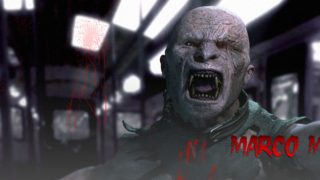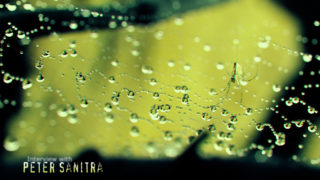
Interview with Jim Moore
“Keep at it, keep looking at tutorials and creating new work and expanding your portfolio… and sooner or later someone will call your name!”
Can you give our readers a short introduction about yourself?
My name is Jim Moore and I’m a concept artist and illustrator living in California. I’ve been creating art for games, entertainment and publishing for the last 10 years.

What is the reason of choosing digital painting as a career? Did you start it just as a hobby or did you see the potential for your career?
I’ve been drawing all my life, so it was more or less inevitable that I’d end up in an art related field. Throughout art school we were too busy trying to learn our craft to give much thought to a career path, but fortunately, recruiters from various companies came in and it really started to give us an idea of what was out there.

Have you had any art related schooling?
I have a degree in Fine Arts from Ringling School of Art and Design. More importantly, I was fortunate enough to have had a strong foundation in traditional media from the community college where I lived. In the end, the most important things for an artist to learn are the fundamentals, so it’s very important to make sure the school you choose has teachers who are able to teach these things.

Where do you get the ideas for these amazing artworks?
Much of the work on my site originates from clients, and in these cases it was my job to build on their vision. For my personal work, I draw inspiration from virtually anywhere. I think it’s important to maintain a curiosity about everything in the world…you never know what will strike you in a unique way and become the basis for some new work.

When you are working on personal projects what type of work do you like to do
I like to seek out new challenges when I do get time to do personal work, partially because I find it satisfying to be able to do a little of everything, but also because as a freelancer, it’s helpful to be able to do many things. So whether it’s a new style that I’ve never worked in before, or a new format, or even a new software package or media, I try to find a way to keep learning whenever I can.
The other thing that I try to emphasize in my personal work is storytelling. Illustration and concept art are really exercises in storytelling at their core, and sometimes this gets lost in a production environment.

Please tell us anything about your work “Gardens of Babylon”, from where you get inspiration and ideas to create this artwork? Please tell us in detail about the process of its creation. What stage was the most difficult for you? How long did you work on it?
“Gardens of Babylon” actually started as an exercise to get more matte painting in my portfolio, but in looking for reference, I quickly found a huge of destroyed city concepts. So, after laying in my initial composition, I started to look for a way to give this work a unique story that would set it apart a bit. As it turns out, I had just seen a program which mentioned the legendary hanging gardens of Babylon, and I liked the idea of this concept which was once a wonder of the world now being the last remnants of a long dead civilization. Also, by covering the ruined skyscrapers in green, this scene is a bit set apart from the standard destroyed city scene which generally uses a lot more gray.
This piece took about 2 days to do, with most of the time going into setting up the composition and color balance. After that it was a fairly straightforward rendering with a simple brush until I got to the point where I wanted to render the vegetation. At this point, it was a matter of finding good photo material to comp in, and also using a custom vegetation brush blend from the photo to the painted areas. The brushes ended up being so good that I actually used a lot less photos than brushwork.


How many renders does it take you to achieve that final perfect image you are happy with?Have you any tricks and your own “know-how” in painting, if it’s not secret tell us about them?
Early on my career I painted as directly as possible in an attempt to emulate how I worked in live media ( Oil and charcoal ). I only used layers sparingly and didn’t really take advantage of any of the masking tools or custom brushes. However these days I really feel that whatever program you use, you should really make it a point to know what every single function does, because you never know when some little function will save you many hours of work. Not only that, for the purposes of working efficiently, you should also know the shortcuts as well. Over the course of several hours or days, the difference between fumbling around with a menu and just hitting a key will really add up. Also, since companies are continually releasing new versions all the time, you never finish learning these tricks. As recently as last month I found a hugely helpful shortcut in photoshop by accident..and I found that my friends in the industry also did not know this trick either! So, it pays to trade tricks with your buddies because you never know what someone else has found!

What do you feel are your most productive working hours? How do you manage to avoid procrastination and hit deadlines effectively
As a freelancer, I don’t have the luxury of procrastinating because most contract work has very short deadlines and you have to be able to schedule accordingly. I find it helps to try to preserve my routine everyday whether I have something on my schedule or not. This way my brain knows when the work hours begin and it makes it a bit easier to focus. The nice part about working from home is that it’s a lot more efficient than an office environment. The hours spent commuting, in meetings, dealing with team members, paperwork and scheduling in the office all go toward the final product at home instead.

How do you manage to combine your personal life and work? Is it easy for you to find the time for your family, friends?
Since most of my friends are in the industry as well it’s easy for them to understand whenever something comes up but in general because of this more efficient way of working I am able to have a healthy balance of work and outside life without too much trouble ordinarily. It’s also much easier to put in extra hours at your convenience when your office is several feet away, instead of several miles.

What advice can you give to artists looking for work or having a desire to make a career in this field?
I’ve helped a few artists break into the industry and I worked with them when their portfolios needed a lot of work and they felt they’d never get their first break. But the ones who kept at it have all made it and are very successful to this day, and that’s really the most important thing for someone just coming into this field: keep at it, keep looking at tutorials and creating new work and expanding your portfolio..this industry is only getting bigger and if you hang around long enough, sooner or later someone will call your name!

Thank you , Jim. We will wish you all the best in your work!









